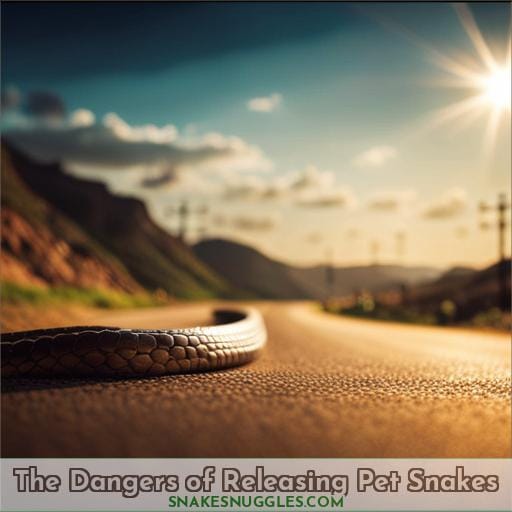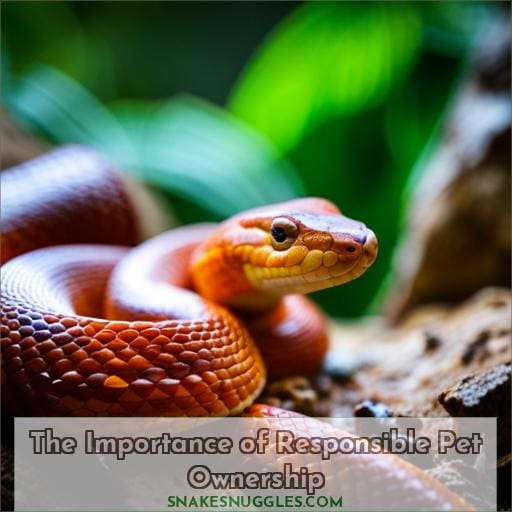This site is supported by our readers. We may earn a commission, at no cost to you, if you purchase through links.
 Imagine the thrill of seeing a pet snake slithering through the wild, embracing its natural instincts. But can pet snakes truly survive in their untamed surroundings? The truth may surprise you.
Imagine the thrill of seeing a pet snake slithering through the wild, embracing its natural instincts. But can pet snakes truly survive in their untamed surroundings? The truth may surprise you.
While some species like the Burmese python have adapted to certain environments, most captive-bred snakes face grim consequences when released into unfamiliar territory. From climate challenges to lack of food sources and predators lurking at every corner, it’s important to understand why releasing a pet snake is rarely a wise choice for both them and their potential impact on ecosystems.
Table Of Contents
- Key Takeaways
- Can Pet Snakes Survive in the Wild?
- The Dangers of Releasing Pet Snakes
- Understanding the Concept of the Wild
- Invasive Species and Legal Issues
- Alternative Options for Rehoming Pet Snakes
- The Importance of Responsible Pet Ownership
- Frequently Asked Questions (FAQs)
- What are the potential risks and dangers for a pet snake if it is released into the wild?
- How do the instincts and physical characteristics of domesticated snakes differ from those of wild snakes?
- What are some common health issues that wild snakes may face, including infections and parasites?
- Why is it not recommended to release domesticated snakes into the wild, even if they resemble venomous snakes?
- What are some alternative options for rehoming a pet snake if the owner can no longer care for it?
- Conclusion
Key Takeaways
- Pet snakes may struggle to survive in the wild due to unsuitable climate conditions, such as temperature, humidity, and sunlight.
- Finding food sources that are suitable for their diet and competing with wild animals for food can be challenging for pet snakes in the wild.
- Pet snakes are vulnerable to predators and may not be able to defend themselves or find shelter from them.
- Sickness and disease can pose a significant threat to pet snakes in the wild, as they may not have access to proper treatment and may struggle to recover.
Can Pet Snakes Survive in the Wild?
When considering whether pet snakes can survive in the wild, several factors must be taken into account.
The climate plays a significant role as snakes require specific temperatures to thrive and may struggle to adapt in different environments.
Additionally, food sources are crucial for their survival, and captive snakes may not possess the necessary hunting skills or adaptability to find prey in the wild.
Predators also pose a threat to pet snakes as they lack defensive mechanisms typically seen in their wild counterparts.
Lastly, sickness and disease are prevalent risks that can weaken or even prove fatal for released pet snakes due to exposure from unfamiliar pathogens present outdoors.
Climate
If you release a pet snake into the wild, it may struggle to survive due to the specific climate requirements that snakes need for their survival.
Snakes are ectothermic creatures, meaning they rely on external sources of heat to regulate their body temperature. They require warm temperatures ranging from 75-85 degrees Fahrenheit for proper metabolic functioning.
In addition to temperature, snakes also need adequate humidity levels and access to sunlight for vitamin D synthesis.
- Temperature regulation
- Humidity maintenance
- Accessible sunlight
Food Sources
In the wild, pet snakes will need to rely on finding their own food sources. They’re skilled hunters and have adapted to survive by preying on a variety of animals.
Snakes have specialized hunting skills and can consume prey that’s larger than their head through unique jaw structures. Their digestion process allows them to break down and absorb nutrients efficiently.
However, in the wild, snakes also face competition from other predators for food resources as well as potential exposure to parasites that can affect their health.
| Availability of Prey | Hunting Skills | Digestion |
|---|---|---|
| Rabbits | Stealth | Efficient |
| Mice | Ambush | Rapid |
| Rats | Constriction | — |
Table: Food Sources for Pet Snakes in the Wild
Predators
As a pet snake released into the wild, you’ll face numerous predators that pose a threat to your survival.
Snakes, while they can be predators themselves, also become prey in their natural habitat.
Birds of prey, badgers, hedgehogs, cougars, and larger snakes are just some of the animals that may see you as a meal.
It’s important to understand the risks involved before considering releasing a pet snake into an unfamiliar environment where it may struggle to survive.
Sickness and Disease
You may encounter various sicknesses and diseases if you release a pet snake into the wild.
- Scale rot, which causes skin ulcers and infections
- Mouth rot, an infectious condition that affects the snake’s mouth
- Intestinal worms found in their prey or water sources
- Mites and ticks can infest a snake’s body, leading to disease and infection
The Dangers of Releasing Pet Snakes
Releasing pet snakes into the wild can have serious consequences for ecosystems, humans, and the snake itself.
Non-native snakes that are released can disrupt natural habitats and threaten native species by preying on them or competing for resources.
Additionally, there’s a risk of these escaped pets coming into contact with humans and potentially causing harm.
It’s important to consider alternative options such as contacting the place of purchase or finding responsible individuals who may be interested in adopting a pet snake rather than releasing it into an unfamiliar environment.
Disruption of Ecosystems
Releasing pet snakes into the wild can cause significant disruption to ecosystems.
When non-native snake species are introduced, they can compete with native species for resources and disrupt the balance of biodiversity.
Additionally, released snakes may introduce new diseases that could harm both wildlife and humans.
It’s crucial to consider the potential consequences before releasing a pet snake into the wild.
Threat to Humans
Releasing pet snakes into the wild poses a threat to humans. Here are three reasons why:
- Venomous snakes can cause serious harm or even death if encountered by unsuspecting individuals, especially children.
- Attacks on humans by pet snakes that have been released into the wild have been reported in various cases.
- Snakes can carry diseases that can be transmitted to humans through bites or contact with their bodily fluids, posing health risks.
Danger for the Snake
Releasing a pet snake into the wild can put it in danger.
- Pet snakes lack natural instincts and the ability to hunt for food, making them vulnerable to starvation.
- They’re also more susceptible to diseases that wild snakes have built immunity against.
- In addition, domesticated snakes haven’t developed defenses against predators found in the wild.
Overall, releasing a pet snake into unfamiliar territory exposes them to various risks and reduces their chances of survival.
Domesticated rabbits weren’t meant to live in the wild.
- The rabbit is likely to die soon after being released.
- Domesticated rabbits lack the necessary instincts and physical characteristics for survival in nature.
- Basic survival skills have been lost through generations of domestication.
Understanding the Concept of the Wild
When considering whether a pet snake can survive in the wild, it’s important to understand the concept of the wild itself.
The natural habitat of snakes is vastly different from urban environments, and releasing a captive snake into unfamiliar territory can have significant consequences for both the snake and native wildlife.
It’s crucial to recognize that non-native species can disrupt ecosystems and threaten local biodiversity when introduced into new areas.
Natural Habitat Vs. Urban Environments
When considering the release of pet snakes into the wild, it’s important to understand the distinction between their natural habitat and urban environments.
Snakes have specific temperature requirements that may not be met in cities.
In their natural habitats, snakes have a variety of food sources available, while urban environments may lack suitable prey.
Additionally, predators pose a threat to released snakes without their natural defenses.
Health risks such as parasites are also more prevalent in the wild.
Releasing non-native species can lead to invasive species issues and legal consequences.
Impact on Native Wildlife
As a responsible pet owner, it’s important to understand the impact that releasing pet snakes into the wild can have on native wildlife.
When non-native snakes are introduced to an ecosystem, they can disrupt the balance of competition for food and displace native snake species. This displacement can lead to a loss of biodiversity and cause an imbalance in the ecosystem.
Additionally, changes in the food web may occur as these released snakes find new prey sources or compete with existing predators for resources.
Invasive Species and Legal Issues
Releasing pet snakes into the wild can have negative effects on local populations.
Non-native species can disrupt ecosystems and cause a decline in native wildlife populations, as they may prey upon or outcompete local species for resources.
Additionally, there are legal consequences to releasing non-native snakes, as it’s often illegal to introduce them into new habitats without proper permits or permissions.
It’s important to consider these factors and explore alternative options when seeking to get rid of a pet snake.
Negative Effects on Local Populations
Continuing with the discussion on the impact of releasing pet snakes into the wild, it’s important to understand the negative effects they can have on local populations and address potential legal issues.
Releasing pet snakes can lead to:
- Competition for resources among native species
- Displacement of native species from their habitats
- Altered food webs due to changes in predator-prey relationships
- Increased predation pressure on vulnerable species
- Loss of genetic diversity within ecosystems
These consequences highlight why responsible ownership and proper rehoming methods are crucial in preventing harm to local wildlife.
Legal Consequences of Releasing Non-Native Snakes
Releasing non-native snakes into the wild can have serious legal consequences, as they’re considered invasive species and pose a threat to native wildlife.
Many countries and states have strict regulations in place to prevent the release of these snakes.
Releasing non-native snakes without proper permits, licenses, or registrations isn’t only illegal but also contributes to environmental impact and disrupts wildlife management and conservation efforts aimed at protecting endangered and protected species.
Alternative Options for Rehoming Pet Snakes
If you find yourself in a situation where you can no longer care for your pet snake, there are alternative options available for rehoming them.
One option is to check the return policy from the supplier or breeder where you purchased the snake.
Another option is to sell or advertise the snake online or through local channels to find someone who may be interested in adopting it.
Seeking assistance from professionals, such as veterinarians, can also provide guidance on what steps to take next in finding a new home for your pet snake.
Return Policies From Suppliers
If you’re looking to rehome your pet snake, consider checking with the place/person you bought it from for their return policy.
Many suppliers have specific policies in place regarding returns and rehoming of animals.
It’s important to gather all necessary documentation, such as proof of purchase, before reaching out to the supplier.
Be aware that there may be time limits or deadlines for returning a pet snake, and fees or costs associated with the process should also be considered.
Understanding refund policies is crucial when exploring alternative options for rehoming your pet snake.
Selling or Advertising the Snake
Looking to rehome your pet snake? Consider selling or advertising it as an alternative option for finding a new owner.
- When looking to buy or sell a pet snake online, it’s essential to prioritize reputable sources for rare snakes (rare snake species for sale) to ensure you’re getting a healthy animal from a responsible breeder. Online classifieds: Platforms like Craigslist allow you to list your snake for sale and reach potential buyers in your area.
- Pet store trade-in: Some pet stores may be willing to take in snakes from owners looking to rehome them, either through direct trade or offering a buying price.
- Snake rescue organizations: Reach out to local snake rescue organizations who may be able to assist in finding a new home for your pet snake, often with adoption fees involved.
Remember that before selling or advertising the snake, familiarize yourself with any applicable local laws regarding ownership and trading of reptiles.
Seeking Assistance From Professionals
You can seek assistance from professionals when it comes to finding alternative options for rehoming your pet snake.
Local animal shelters, reptile rescues, humane societies, wildlife rehabilitators, and even pet stores may be able to provide guidance and resources for safely rehoming your snake.
These organizations have experience in handling reptiles and can help ensure that your pet finds a suitable new home where its needs will be properly met.
Don’t hesitate to reach out for professional assistance when considering rehoming your pet snake.
The Importance of Responsible Pet Ownership
To be a responsible pet owner, it’s crucial to research and understand the specific needs of pet snakes.
This includes providing proper care in terms of temperature, feeding, and habitat.
It’s also important to commit to the long-term care of your snake and seek advice or support from experts when needed.
By being knowledgeable and dedicated, you can ensure the well-being and survival of your pet snake without resorting to releasing them into the wild.
Researching and Understanding the Needs of Pet Snakes
To properly care for a pet snake and ensure responsible ownership, it’s crucial to research and understand their specific needs.
This includes:
- Providing a proper enclosure with the right temperature conditions.
- Offering a suitable diet that meets their nutritional requirements.
- Learning how to handle them safely and appropriately.
- Scheduling regular vet care visits to monitor their health.
By educating yourself on these aspects of snake ownership, you can provide the best possible care for your pet.
Commitment to Providing Proper Care
Take responsibility for properly caring for your pet snake.
Providing a proper enclosure is crucial to ensure their safety and well-being.
Regular socialization and enrichment activities are important for their mental stimulation.
Don’t forget about regular vet care to monitor their health and address any potential issues.
Training your snake can also help establish boundaries and promote positive behaviors.
By committing to providing proper care, you’ll be ensuring the happiness and longevity of your pet snake.
Seeking Advice and Support From Experts
If you’re unsure about how to properly care for your pet snake, it’s essential to seek advice and support from experts in order to ensure responsible ownership.
Here are three resources that can provide valuable guidance:
- Local reptile rescues and humane societies
- Animal control agencies knowledgeable about snakes
- Reptile forums and online resources with experienced snake owners who can share their expertise.
These sources will help you understand the specific needs of your pet snake and ensure its well-being in captivity.
Frequently Asked Questions (FAQs)
What are the potential risks and dangers for a pet snake if it is released into the wild?
Releasing a pet snake into the wild poses potential risks and dangers.
The snake may struggle to find suitable temperatures, food sources, and could become vulnerable to predators.
It’s cruel and irresponsible to release captive snakes into unfamiliar environments.
How do the instincts and physical characteristics of domesticated snakes differ from those of wild snakes?
The instincts and physical characteristics of domesticated snakes differ from those of wild snakes.
Domesticated snakes lack the necessary skills for survival in the wild, making it dangerous to release them.
They rely on humans for food, shelter, and care.
What are some common health issues that wild snakes may face, including infections and parasites?
Wild snakes can face a range of health issues, including:
- Bacterial infections like scale rot and stomatitis.
- Intestinal parasites.
- Infestations of mites and ticks.
These conditions can have serious consequences for their survival in the wild.
Why is it not recommended to release domesticated snakes into the wild, even if they resemble venomous snakes?
Releasing domesticated snakes into the wild isn’t recommended, even if they resemble venomous snakes. It disrupts ecosystems and poses risks to both humans and the snake itself. There are alternative options available for rehoming pet snakes responsibly.
What are some alternative options for rehoming a pet snake if the owner can no longer care for it?
If you can no longer care for your pet snake, there are alternative options available.
- Contact the place/person you bought it from.
- Advertise its sale online.
- Seek out individuals actively searching for a snake.
Consult with a veterinarian or professional for further guidance.
Conclusion
To conclude, the truth is that pet snakes generally can’t survive in the wild. The climate, lack of food sources, presence of predators, and susceptibility to sickness and disease make it challenging for captive-bred snakes to adapt to unfamiliar environments.
Releasing pet snakes can have detrimental effects on ecosystems, pose threats to humans, and put the snake’s own well-being at risk. It’s crucial to understand the concept of the wild, the impact on native wildlife, and the legal consequences of releasing non-native snakes.
Responsible pet ownership and alternative rehoming options are essential for ensuring the well-being of pet snakes.











